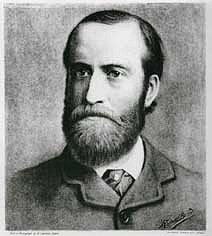
Steyning Museum archives - Steyning and the Irish Question
One sunny Sunday in the late June of 1998 the Irish ambassador to the United Kingdom stood on the pavement behind the railings at the junction of Church Street and the High Street, trying to make his voice heard above the noise of passing traffic. He was addressing a group of more than 50 local dignitaries, academics and representatives of the press but, outnumbering all of these, were friends and members of The Parnell Societies of Ireland and of West Sussex.They were there to honour the memory of a great man, Charles Stewart Parnell, a man Gladstone described as “the most remarkable man I ever met, and the most interesting”. And they chose to come to Steyning because it was there at Osborne House, almost exactly 107 years before, that Parnell married Katherine O’Shea in 1891, the day after his 45th birthday.
The cast of the leading players in this story is short.
First there was Parnell himself. Between 1875 and his death just 4 months after his marriage he worked robustly and tirelessly for equitable rents for Irish peasants (“Poor fellows” he once called them) and for Home Rule for Ireland. By mastering parliamentary procedure Parnell and his block of Irish MP’s made the ruling parties take account of his influence and by 1885 his party held the balance of power in a hung parliament. A bill to give Irishmen Home Rule became a possibility but, after 16 days and nights of debate, it was eventually defeated.
Then there was Katherine O’Shea, who was called Katie by her friends but by her enemies was referred to as ‘Kitty’, a name with connotations of prostitution. She first met Parnell in 1880, having previously separated from her husband, an Irish Nationalist MP, in 1875, and they became devoted to each other. But Captain O’Shea refused to divorce her because he had expectations from her rich aunt. When this didn’t materialise he eventually filed for divorce naming Parnell as co-respondent – a move which, given Victorian attitudes, proved to be disastrous for Parnell’s political career.
Why Parnell and Katherine came to be married in Steyning needs a certain amount of explanation. Katherine’s divorce from Captain O’Shea had just come through, giving them the freedom to get married. They were living in Brighton and immediately set about trying to find a clergyman willing to marry them in Church. But the Bishop of Chichester had issued orders that none of his clergymen should conduct a marriage service for anyone who had been divorced. So Parnell and Katherine decided that they would need to resort to a registry office wedding. And that is where Steyning came into the picture. The part of Brighton where they lived was in the registration district for which Steyning was the principal town – and Osborne House, in 1891, was the Registry Office.
When it came to their wedding day they knew that Tom, their groom, would pass details of their plans to the press, who were following their every move. So they asked him to bring the carriage round at 11.00 but then surprised him by waking him at 6.00. Two of their servants were their witnesses at the wedding and, again in the interests of security, they were sent ahead by train. Consequently, when Parnell and Katherine reached Steyning for the 9.00 ceremony, they were free of press attention – though Katherine had constantly been fearful, during the journey, that she was hearing pursuing horses. As the carriage drew up at the registry office Levi West, who lived just up Sheep Pen Lane, was passing by and helpfully opened the carriage door – a courtesy which earned him a golden sovereign.
The final word, however, must go to Edward Cripps, the Steyning Registrar. He recalled that, despite Parnell’s reputation of being cold and reserved, “When I married them he struck me as one of the happiest bridegrooms I have ever married”.

